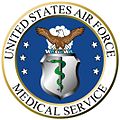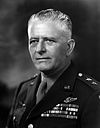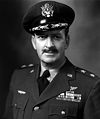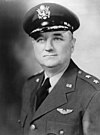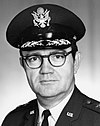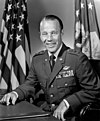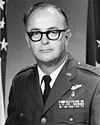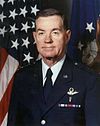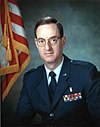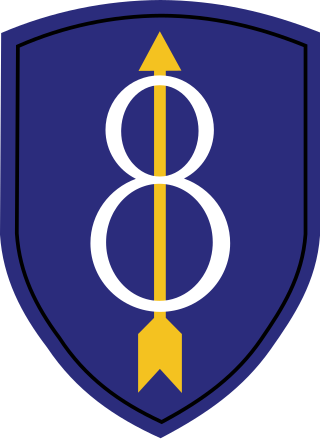
The 8th Infantry Division, ("Pathfinder") was an infantry division of the United States Army during the 20th century. The division served in World War I, World War II, and Operation Desert Storm. Initially activated in January 1918, the unit did not see combat during World War I and returned to the United States. Some units would serve in the American Expeditionary Force to Siberia. Activated again on 1 July 1940 as part of the build-up of military forces prior to the United States' entry into World War II, the division saw extensive action in the European Theatre of Operations. Following World War II, the division was moved to West Germany, where it remained stationed at the Rose Barracks in Bad Kreuznach until it was inactivated on 17 January 1992.
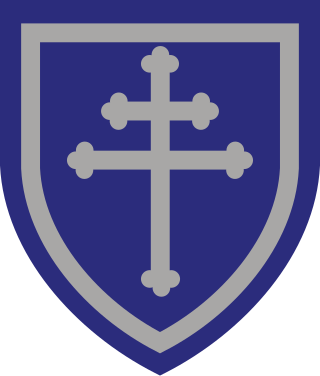
The 79th Infantry Division was an infantry formation of the United States Army Reserve in World Wars I and II.

The 90th Infantry Division was a unit of the United States Army that served in World War I and World War II. Its lineage is carried on by the 90th Sustainment Brigade.

Lewis Hyde Brereton was a military aviation pioneer and lieutenant general in the United States Air Force. A 1911 graduate of the United States Naval Academy, he began his military career as a United States Army officer in the United States Army Coast Artillery Corps prior to World War I, then spent the remainder of his service as a career aviator.

The Royal New Zealand Army Medical Corps (RNZAMC) is a corps of the New Zealand Army, the land branch of the New Zealand Defence Force (NZDF). The Medical Corps provides for the medical needs of soldiers, such as diagnosing and treating diseases and injuries. Medical personnel are part of almost all Army exercises and operations, and personnel work in conjunction with personnel from the Royal New Zealand Dental Corps and the Royal New Zealand Nursing Corps.

Harry George Armstrong was a major general in the United States Air Force, a physician, and an airman. He is widely recognized as a pioneer in the field of aviation medicine. The Armstrong limit, the altitude above which water boils at the temperature of the human body, is named after him.

The United States Army Field Artillery School (USAFAS) trains Field Artillery Soldiers and Marines in tactics, techniques, and procedures for the employment of fire support systems in support of the maneuver commander. The school further develops leaders who are tactically and technically proficient, develops and refines warfighting doctrine, and designs units capable of winning on future battlefields. The school is currently located at Fort Sill, Oklahoma.

On 15 June 1944, United States Marine forces landed on the southwest coast of the island of Saipan in the central Marianas chain; these were followed a day later by US Army forces. This invasion was part of Operation Forager, an effort to recapture the entire Marianas chain from the Empire of Japan.

Major General Malcolm Cummings Grow was the first Surgeon General of the United States Air Force from July 1, 1949 to November 30, 1949.
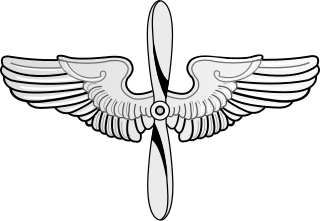
The United States Army Air Corps (USAAC) was the aerial warfare service component of the United States Army between 1926 and 1941. After World War I, as early aviation became an increasingly important part of modern warfare, a philosophical rift developed between more traditional ground-based army personnel and those who felt that aircraft were being underutilized and that air operations were being stifled for political reasons unrelated to their effectiveness. The USAAC was renamed from the earlier United States Army Air Service on 2 July 1926, and was part of the larger United States Army. The Air Corps became the United States Army Air Forces (USAAF) on 20 June 1941, giving it greater autonomy from the Army's middle-level command structure. During World War II, although not an administrative echelon, the Air Corps (AC) remained as one of the combat arms of the Army until 1947, when it was legally abolished by legislation establishing the Department of the Air Force.
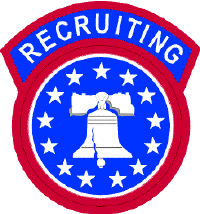
The United States Army Recruiting Command, located at Fort Knox, Kentucky, is responsible for the recruitment and accession of new Soldiers for the United States Army and Army Reserve. Recruiting operations are conducted throughout the United States, U.S. territories, and at U.S. military facilities in Europe, Asia, and the Middle East. This process includes the recruiting, medical and psychological examination, induction, and administrative processing of potential service personnel.
In September 2020, the Army realigned the previously consolidated CIO/G-6 function into two separate roles, Office of the Chief Information Officer and Deputy Chief of Staff, G-6, that report to the secretary of the Army and chief of staff of the Army, respectively. The realignment came after several months of planning and coordination. Lt. Gen. John Morrison was nominated to the Senate for promotion and assignment as the G-6 and confirmed, assuming that position in August 2020.Subsequently, the Secretary of the Army, Ryan McCarthy appointed Dr. Raj G. Iyer as the first civilian Chief Information Officer, a career Senior Executive Service position in November 2020.
The Seventh Corps Area was a Corps area, effectively a military district, of the United States Army active from 1920 to 1941. It initially was responsible for army forces in Kansas, Minnesota, Missouri, North Dakota, South Dakota, Iowa and Nebraska. Army responsibility for Arkansas was transferred from the Fourth Corps Area to the Seventh Corps Area on 1 December 1920. In October 1940, the War Department implemented a transfer of tactical command functions of the Corps areas, moving tactical forces to field armies and transforming the Corps areas to Service Commands, themselves part of Army Service Forces. The Seventh Corps Area maintained its name until May 1941, when it was officially designated HQ, Seventh Corps Area Service Command in May 1941. While the Seventh Corps Area no longer existed, the HQ, Seventh CASC – later re-designated HQ, Seventh Service Command – continued until January 1944.
The Fifth Corps Area was a military district of the United States Army from 1920-21 to the Second World War. The Fifth Corps Area included the states of Indiana, Ohio, West Virginia, and Kentucky. Eventually it became Fifth Service Command on 22 July 1942, and then Fifth Service Command was disestablished in 1946.
Sixth Corps Area was a Corps area, effectively a military district, of the United States Army from 1921 to the 1940s. The headquarters was established at Fort Sheridan, Illinois, in August 1920, from portions of the former Central Department, but then moved to the U.S. Post Office Building at 1819 West Pershing Road in Chicago on 10 October 1921.

On 21 July 1944, United States Marine and Army forces invaded the island of Guam, the southernmost of the Mariana Islands chain in the Central Pacific, with the intent to take control of the island from the Imperial Japanese Army. Operation Forager II, as it was called by American planners, was a phase of the Pacific Theatre of World War II.

On February 19, 1945, men of the United States Marine Corps invaded the island of Iwo Jima, part of the Volcano Islands chain, in the North Pacific. This invasion, known as Operation Detachment, was a phase of the Pacific Theatre of World War II. The American goal was to establish multiple airfields that would allow escort fighters to accompany long-range bombers in their attacks on the Japanese home islands, as well as providing a place for damaged bombers to land on the return flight.
